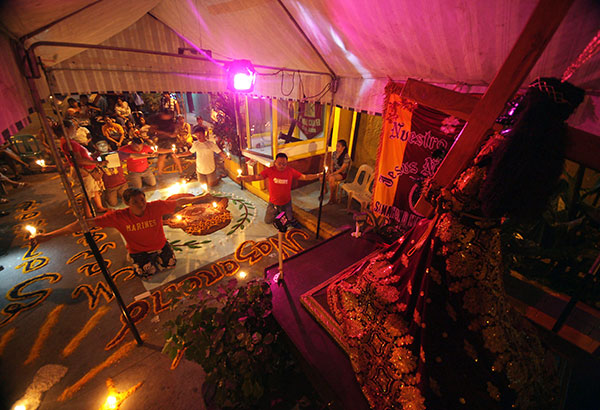Classes, work suspended for Nazarene feast

Devotees of the Black Nazarene pray during a novena at the Quiapo Church in Manila yesterday. Miguel De Guzman
MANILA, Philippines — Classes at all levels and work at the Manila city hall are suspended for the feast of the Black Nazarene on Jan. 9, Mayor Joseph Estrada announced yesterday.
Estrada signed Executive Order No. 1 suspending classes in public and private schools as well as universities and colleges in the city.
“The suspension was made to ensure public order and the safety of millions of devotees expected to join the procession of the Black Nazarene,” Estrada said.
He said the suspension of work in national government and private offices in the city is up to Malacañang.
Manila is hosting the International Pilgrimage of the Black Nazarene.
“I will be the hermano mayor again for the feast of the Black of Nazarene,” Estrada said.
MPD inspects traslacion route
Officials of the Manila Police District (MPD) yesterday inspected the route of the traslacion or the procession of the Black Nazarene.
MPD director Chief Superintendent Joel Coronel led officials of the city government in inspecting the 5.96-kilometer route of the traslacion from the Quirino Grandstand to Quiapo Church, the Minor Basilica of the Black Nazarene.
Coronel was joined by Monsignor Hernando Coronel, rector of the Quiapo Church, and officials of the Department of Public Works and Highways.
Coronel said the image of the Black Nazarene would no longer pass through Lagusnilad Bridge and instead counterflow to the westbound lane of P. Burgos street heading toward Jones Bridge.
“The procession will not pass through Lagusnilad overpass to ensure the safety of the devotees,” Coronel said.
He said road obstructions such as electric cables and open manholes need to be cleared.
Millions of Catholic devotees are expected to join the procession.
Superintendent Lucille Faycho of the MPD said last year’s crowd estimated at 18 million during the 10-day novena prior to the Black Nazarene feast could increase to 18.9 million this year.
In 2006, a male devotee died after a wooden plank covering a manhole collapsed.
Coronel said devotees who would jump over the Jones Bridge would be arrested.
Brig. Gen. Alan Arrojado, newly designated commander of the Armed Forces of the Philippines-Joint Task Force National Capital Region, said he would deploy a battalion of soldiers to assist police in securing the procession.
The traslacion will start from the Quirino Grandstand (Independence Road), turn right to Katigbak Drive straight to P. Burgos (westbound lane) going to P. Burgos (southbound lane) through Jones Bridge, turn right to Dasmariñas, left to Palanca Street, left to Quezon Boulevard, right to Arlegui, right to Fraternal, right to Vergara, left to Duque de Alba, left to Castillejos, left to Farnecio, right to Arlegui, left to Nepomuceno (counterflow), left to Aguila, right to Carcer, left to Hidalgo through Plaza del Carmen, left to Bilibid Viejo, left to Guzman, right to Hidalgo, left to Bautista (Barbosa), right to Globo de Oro under Quezon Bridge, right to Palanca, right to Villalobos and then Plaza Miranda going to Quiapo Church.
Church 100 percent ready
Fr. Douglas Badong, parochial vicar of the Quiapo Church said they are “100 percent ready.”
Badong said church officials have been meeting with officials of the Manila city government, National Parks Development Committee and other local offices in preparation for the event.
Aside from the thanksgiving procession last Dec. 31, Badong said there would be a procession of the replicas of the image of the Black Nazarene on Jan. 7.
There would be slight changes in the procession route to speed up the traslacion.
Badong said last year’s processon took 21 hours.
“We hope that the procession would be shorter this year. Last year was the longest traslacion,” he said.
Alex Irasca, a member of the Traslacion 2018 organizing committee, said there would be 12 prayer stations along the procession route. – With Evelyn Macairan, Jaime Laude
- Latest
- Trending



















